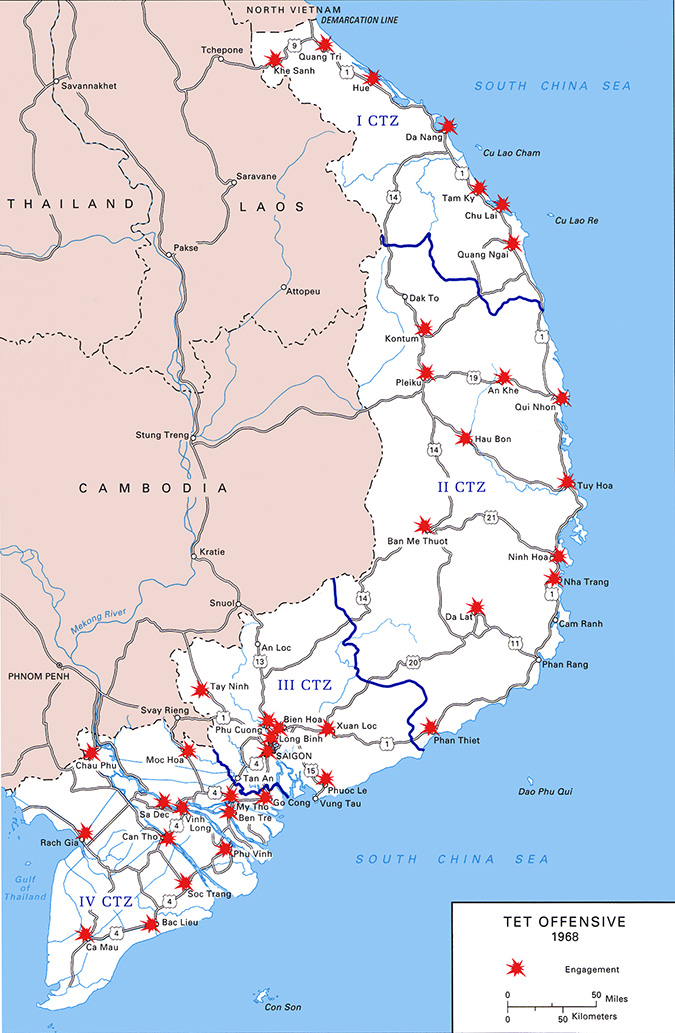Week of February 5
This week in history, at the end of January 1968, Việt Cộng and other Communist forces launched hundreds of simultaneous attacks on cities, towns, and military installations throughout South Vietnam. The attacks became known as the Tet Offensive, which lasted through all of February and into March. Tet ultimately proved to be a major turning point in the war and became one of the most significant events in American history.
On the night of January 30–31, 1968, during the Vietnamese New Year celebrations known as Tet (customarily a ceasefire period observed by both sides), Communist insurgents launched the offensive. North Vietnam and insurgent leaders had been planning the attacks since early 1967. Their objective was to defeat the South Vietnamese Army and spark a popular uprising across the country, potentially ending the war in one bold stroke. Roughly 84,000 enemy combatants participated in well coordinated and timed attacks on 36 provincial capitals and 64 district towns, as well as numerous American and South Vietnamese military facilities. American intelligence reports had long suspected that a major enemy operation was imminent. But many expected it to be an all-out invasion across the Demilitarized Zone and thus were largely unprepared for the sudden nation-wide attacks.
Heavy fighting occurred throughout the country, but the vast majority of Tet attacks were stopped by the swift counterattacks of American and allied troops. Only in the city of Huế were Communist forces successfully able to occupy a South Vietnamese city, and they held it for weeks. Though isolated, South Vietnamese and U.S. Marine and Army troops based in Huế resisted the Việt Cộng forces in bitter house-to-house fighting, which resulted in high numbers of military and civilian casualties. The battle for Huế lasted for nearly a month, during which time Việt Cộng leaders arrested and executed as many as 3,000 civilians they accused of cooperating with the Sài Gòn regime. Before U.S. Marine and Army forces retook the city, nearly 80 percent of Huế’s buildings were destroyed or damaged, and more than 100,000 of its residents were left homeless.
The Tet Offensive was the occasion for uncountable acts of bravery and sacrifice on the part of allied forces. Initially surprised U.S. troops succeeded in blunting and then defeating most of the Tet attacks, despite receiving almost no warning beforehand. Further, U.S. Air Force, Marine, Army, and Navy aviators provided crucial and timely air support, and they transported tens of thousands of wounded men and women to medical facilities during the month of February alone, saving many lives in the process.
The offensive ended nearly everywhere by the end of February, though the fighting in Huế lasted until March. In a narrow sense, the Tet Offensive was a disastrous tactical defeat for the Viet Cong and for Hà Nội. As many as 50,000 Việt Cộng and North Vietnamese combatants were killed, and the offensive achieved none of its major objectives. The Việt Cộng were severely crippled by their losses, and they were largely unable to mount new combat operations for the remainder of the war. The U.S. and South Vietnamese militaries lost more than 2,100 and 4,000 lives, respectively, and all other allied nations lost a total of 214 dead. Officials estimated that at least 12,500 civilians were killed, and urban warfare in Sài Gòn, Huế, and other towns and cities resulted in hundreds of thousands of homeless refugees.
While Tet was a tactical defeat for North Vietnam and the Communist armed forces, it was a strategic victory for them in the long run. The offensive shocked the American public, and sowed increasing doubts about the United States’ chances of preventing the fall of South Vietnam. In the vast majority of instances, U.S. troops were successful in defeating Tet’s attacks. But coupled with news of the widespread fighting and dying, vivid photographs and film clips of the violence and destruction in Sài Gòn raised questions in the United States about whether American forces had made significant progress since 1965.
General William C. Westmoreland, President Lyndon B. Johnson, and many of America’s political and military leaders had spent the closing months of 1967 assuring the public that the United States was nearing the “light at the end of the tunnel” in Vietnam. The Tet Offensive seemed to entirely contradict those assurances, and Hà Nội’s resolve appeared far from weakening. Historians later demonstrated that the Tet Offensive represented the tipping point for America’s support of Johnson’s Vietnam War policies, and public focus shifted away from winning the war, in favor of simply ending it.1
1Graham A. Cosmas, United States Army in Vietnam: MACV: The Joint Command in the Years of Withdrawal, 1968–1973 (Washington, D.C.: Center of Military History, 2006), 36–37, 58–60, 71, 84–85, 102–4, 124, 226; George C. Herring, America’s Longest War: The United States and Vietnam, 1950–1975 (4th edition; New York and other cities: McGraw Hill, 2002), 225–51; Spencer C. Tucker, ed., The Encyclopedia of the Vietnam War: A Political, Social, and Military History (2nd edition; Santa Barbara, CA: ABC-CLIO, 2011), 876–77, 1102–7; Jack Shulimson, et. al., U.S. Marines in Vietnam: The Defining Year, 1968 (Washington, D.C.: U.S. Marine Corps History and Museums Division, 1997), 164–223; William M. Hammond, United States Army in Vietnam: Public Affairs: The Military and the Media, 1968–1973 (Washington, D.C.: Center of Military History, 1996), 9–10, 155, 225; Spurgeon Neel, Vietnam Studies: Medical Support of the U.S. Army in Vietnam, 1965–1970 (Washington, D.C.: Center of Military History, 1991), 71–72.

|
This map shows most of the large-scale attacks of the Tet Offensive, January–February 1968. Many of the offensive’s less significant attacks are not represented here, however. (Map taken from Cosmas, MACV: The Joint Command in the Years of Withdrawal, 1968–1973, 60)